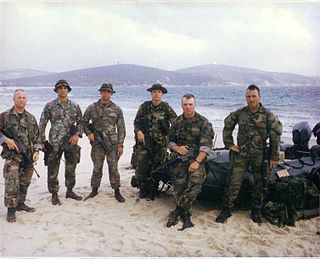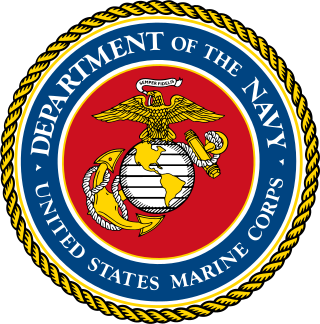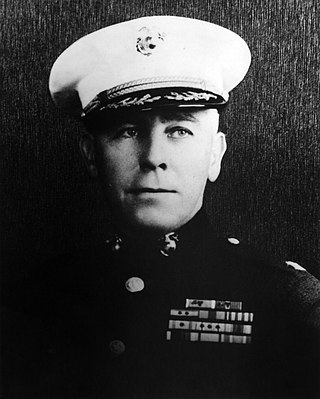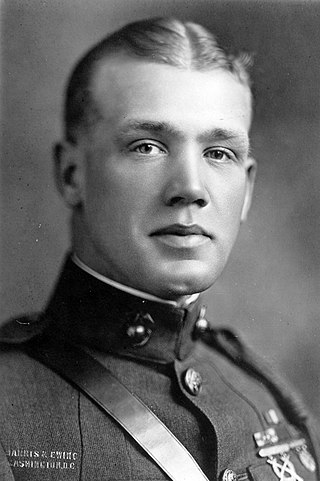
Charles Chandler Krulak is a retired United States Marine Corps four-star general who served as the 31st Commandant of the Marine Corps from July 1, 1995 to June 30, 1999. He is the son of Lieutenant General Victor H. "Brute" Krulak, who served in World War II, Korea, and Vietnam. He was the 13th President of Birmingham-Southern College after his stint as a non-executive director of English association football club Aston Villa.

III Marine Expeditionary Force is a formation of the Marine Air-Ground Task Force of the United States Marine Corps. It is forward-deployed and able to rapidly conduct operations across the spectrum from humanitarian assistance and disaster relief (HA/DR) to amphibious assault and high-intensity combat.

Raymond Gilbert Davis was a United States Marine Corps four-star-general who had served in World War II, the Korean War, and the Vietnam War. Davis was decorated several times, he was awarded the Navy Cross during World War II and the Medal of Honor during the Korean War. While serving as the Assistant Commandant of the Marine Corps, he retired with over 33 years service in the Marine Corps on March 31, 1972.

Christian Frank Schilt was one of the first Marine Corps aviators and a recipient of the United States highest military decoration, the Medal of Honor. He received the Medal for using his biplane to evacuate wounded Marines under fire in Nicaragua.

The Radio Reconnaissance Platoon is a specially trained Marine Corps Intelligence element of a United States Marine Corps Radio Battalion. A Radio Reconnaissance Team (RRT) was assigned as the tactical signals intelligence collection element for the Marine Corps Special Operations Command, Detachment One. Regular RRTs also participate in SOC operations during Marine Expeditionary Unit, or MEU(SOC), deployments.

The United States Marine Corps is organized within the Department of the Navy, which is led by the Secretary of the Navy (SECNAV). The most senior Marine commissioned officer is the Commandant of the Marine Corps, responsible for organizing, recruiting, training, and equipping the Marine Corps so that it is ready for operation under the command of the unified combatant commanders. The Marine Corps is organized into four principal subdivisions: Headquarters Marine Corps, the Operating Forces, the Supporting Establishment, and the Marine Forces Reserve.

George Ronald Christmas is a retired United States Marine Corps lieutenant general. Christmas was awarded the Navy Cross and Purple Heart for valor in 1968, during the Vietnam War. He served on active duty in the Marine Corps for 34 years, retiring in 1996. After retirement, he served as the President and CEO of the Marine Corps Heritage Foundation for 15 years.

William Kenefick Jones was a United States Marine Corps lieutenant general and a highly decorated veteran of three wars, receiving the Navy Cross, the Silver Star, the Bronze Star, and the Purple Heart. He was a battalion commander in World War II; a regimental commander just after the Korean War; and a division commander during the Vietnam War. LtGen Jones' last command was the Fleet Marine Force, Pacific. He served in the Marine Corps for 33 years, retiring from active duty in 1972.

Major General Wayne Evan Rollings, USMC was Commanding General, II Marine Expeditionary Force, III Marine Expeditionary Force and a recipient of the Navy Cross.

Lieutenant General Richard P. Mills is a retired United States Marine Corps officer, who served as commander of the Marine Forces Reserve from 2013 to 2015 and Marine Forces North, headquartered at the Marine Corps Support Facility New Orleans. Previously he was deputy commandant for combat development and integration and commanding general, Marine Corps Combat Development Command in Quantico, Virginia, and, prior to that assignment, was commander of the I Marine Expeditionary Force (Forward)/Regional Command Southwest in Afghanistan.

Vincent Raymond Stewart is a retired Jamaican American lieutenant general in the United States Marine Corps who most recently served as Deputy Commander at United States Cyber Command. He previously served as the 20th Director of the Defense Intelligence Agency (DIA). LtGen Stewart, who held that post from January 23, 2015 through October 3, 2017, was the first African American, first Jamaican American and first Marine to hold the position of Director of the DIA.

Francis Butler Loomis Jr. was a decorated officer of the United States Marine Corps, who reached the rank of major general. He is most noted as executive officer of the 1st Defense Battalion during the Shelling of Johnston and Palmyra and later as Logistic Officer of III Marine Amphibious Corps during Battle of Okinawa. He was the son of United States Assistant Secretary of State, Francis B. Loomis.

Bertram Allison Bone was a decorated officer of the United States Marine Corps with the rank of brigadier general. He is most noted for his service as commanding officer, 1st Defense Battalion during the early phase of the World War II. He later served with V Amphibious Corps during Battle of Leyte and led 10th Marine Regiment during the Battle of Okinawa.

Lewis Cheatham Hudson was a highly decorated officer of the United States Marine Corps with the rank of brigadier general. Hudson received the Navy Cross, the United States military's second-highest decoration awarded for valor in combat, while leading 2nd Battalion, 25th Marines during Battle of Iwo Jima in February 1945. He later commanded Troop Training Unit, Atlantic Fleet or 3rd Marine Division and retired in 1961.

Richard Potts Ross Jr. was a highly decorated officer of the United States Marine Corps with the rank of brigadier general. He is most noted for his service with the 1st Marine Division during the Battle of Okinawa and later during the Occupation of North China.

Daniel Daejin Yoo is a retired U.S. Marine Corps major general and former commander of United States Marine Corps Forces Special Operations Command. He was the first Korean-American general in the history of the United States Marine Corps.

William George Joslyn was a decorated officer in the United States Marine Corps with the rank of major general. A veteran of three wars, Joslyn distinguished himself in the Korean War and rose to the rank of general during the Vietnam War. He completed his career as commanding general, 2nd Marine Division.

Kenneth Wachter Benner was a decorated officer in the United States Marine Corps with the rank of Brigadier general. A graduate of the United States Naval Academy, he trained as Anti-Aircraft Artillery officer and participated in the Defense of Pearl Harbor, Guadalcanal Campaign and Battle of Okinawa.

Harold Cyrus Roberts was a highly decorated officer in the United States Marine Corps with the rank of colonel. He was the recipient of three Navy Crosses, the United States military's second-highest decoration awarded for valor in combat.

On 21 July 1944, United States Marine and Army forces invaded the island of Guam, the southernmost of the Mariana Islands chain in the Central Pacific, with the intent to take control of the island from the Imperial Japanese Army. Operation Forager II, as it was called by American planners, was a phase of the Pacific Theatre of World War II.






















